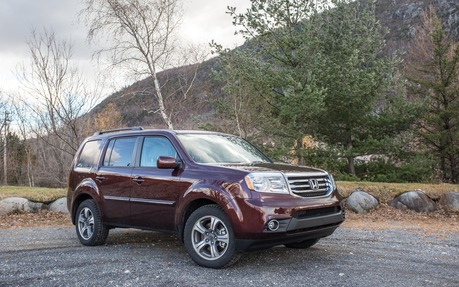2015 Honda Pilot: It’s Hip To Be Square
Take a ride around the lot of a Honda dealership and the first vehicles you see are the Civic, Fit and Accord. This makes perfect sense since those are the brand's most recent models. Next come the CR-V and Odyssey. At the back of the lot, however, you’ll see two square vehicles in the distance: the Ridgeline and the Pilot (which, by the way, are based on the same platform).
The case of the Pilot is unique in that it’s been around in its current form for seven years now, which is a lifetime in the world of automobiles. Although given a new front treatment in 2012, its base has remained unchanged. We've always liked the big ol’ Pilot (we even included it among our Top Three Best Buys until last year), but while this vehicle cruised on auto pilot, the competition picked up speed and passed it.
- Also: 2014 Honda Pilot: Will it Stay or Will it Go?
- Also: 2009 Honda Pilot earns highest possible safety ratings
Box cut
The Pilot’s history is an atypical one. While most vehicles become rounder over time, Honda's SUV did the exact opposite. Whereas the first version was a little more aerodynamic, the current version features some sharp angles: from the front bumper to the side panels and roof to the tail end, there are only flat surfaces. That's not necessarily a bad thing: in a sea of curvy vehicles, the Pilot stands out and gives the impression that it's bigger than it actually is. Moreover, it doesn't try to hide by looking like a crossover—it has unapologetically big headlights, an imposing front grille and large windows.
Inside is where it’s at
Inside, the dashboard is a bit more modern, but only a bit. It is very angular and most functions are button-controlled (buttons are used a lot less these days but, until recently, they were used to activate everything!). The shifter is mounted on the dash, directly to the right of the steering wheel. This configuration frees up space between the front seats. However, the overall quality of the passenger compartment leaves something to be desired with ubiquitous hard plastics, a dated infotainment system and a look that won't please everyone. That said the Pilot will appeal to people with children or lots of gear. Since it's square, there’s lots of room aboard and headroom is excellent. The vehicle is more than capable of seating up to eight people. Perhaps not eight overweight adults, but children can sit in the back comfortably. Second-row passengers have their own temperature controls for their comfort, as well as an electrical outlet. An entertainment system is also available to entertain kids of all ages on long trips. Note that once the rear benches are folded down, the SUV's loading capacity is 2,464 litres and it can accommodate objects measuring up to 1.2 m in width.
A nostalgic ride
Driving the Honda Pilot really takes me back. Firstly, its mechanics haven't changed at all: a 3.6-litre V6 with a five-speed automatic transmission is still on the menu, just like back in the day. The steering wheel gets plenty of assistance, is light and relays almost no feedback from the road. The engine’s 250 horsepower is barely sufficient and the gearbox lags well behind current technology. The car I test drove came with the VTM-4 option, meaning that my Pilot benefitted from all-wheel drive on demand. However, the basic version has front-wheel drive. The all-wheel drive option also comes with a transmission oil cooler, which means that the Pilot can tow up to 2,045 kilograms (4,500 pounds). Visibility isn't as bad as you might think thanks to the large windows, and the rearview camera that helps park the SUV with confidence.
Welcome to the modern world?
It’s inevitable: the Honda Pilot is going to be updated soon (ironically, this isn’t the first year that an imminent makeover has been announced), and not a moment too soon. It needs to get with the times if it wants to stay competitive. But as far as the current generation is concerned, if you’re prepared to accept certain anachronisms like the five-speed gearbox, wheezy engine and lack of technology even in the best-equipped versions, you’ll get a tireless, reliable vehicle that is ready and able to transport just about anything you wish, be it a horde of children or supplies to renovate your bathroom. Finally, note that in some circumstances, the Pilot’s unchanged appearance plays in your favour: no one will be able to determine with certainty if you’re driving a spanking new SUV or a well-maintained used model.
| Test drive report | |
| Test model | 2015 Honda Pilot |
|---|---|
| Trim level | Special Edition |
| Price range | $35,100 – $48,850 |
| Price as tested | CA$40,990 |
| Warranty (basic) | 3 years/60,000 km |
| Warranty (powertrain) | 5 years/100,000 km |
| Fuel economy (city/highway/observed) | 12.3 / 8.2 / 14.5 L/100km |
| Options | N/A |
| Competitive models | Chevrolet Traverse, Ford Flex, GMC Acadia, Nissan Murano, Toyota Highlander |
| Strong points |
|
| Weak points |
|
| Editor's rating | |
| Fuel economy | A more up-to-date transmission would help the cause. |
| Value | The base price is good, but it’s hard to justify a new Pilot when the used models are identical. |
| Styling | Because it’s out of style, the Pilot is now one of the only square vehicles on the road. |
| Comfort | The vehicle is comfortable for all passengers, although it’s a little noisy on the road. |
| Performance | The Pilot is not an out-and-out 4x4, but can nonetheless take on difficult terrain. |
| Overall | If you aren’t in the market for the latest technological innovations out there, Honda has an eight-passenger SUV for you. |
